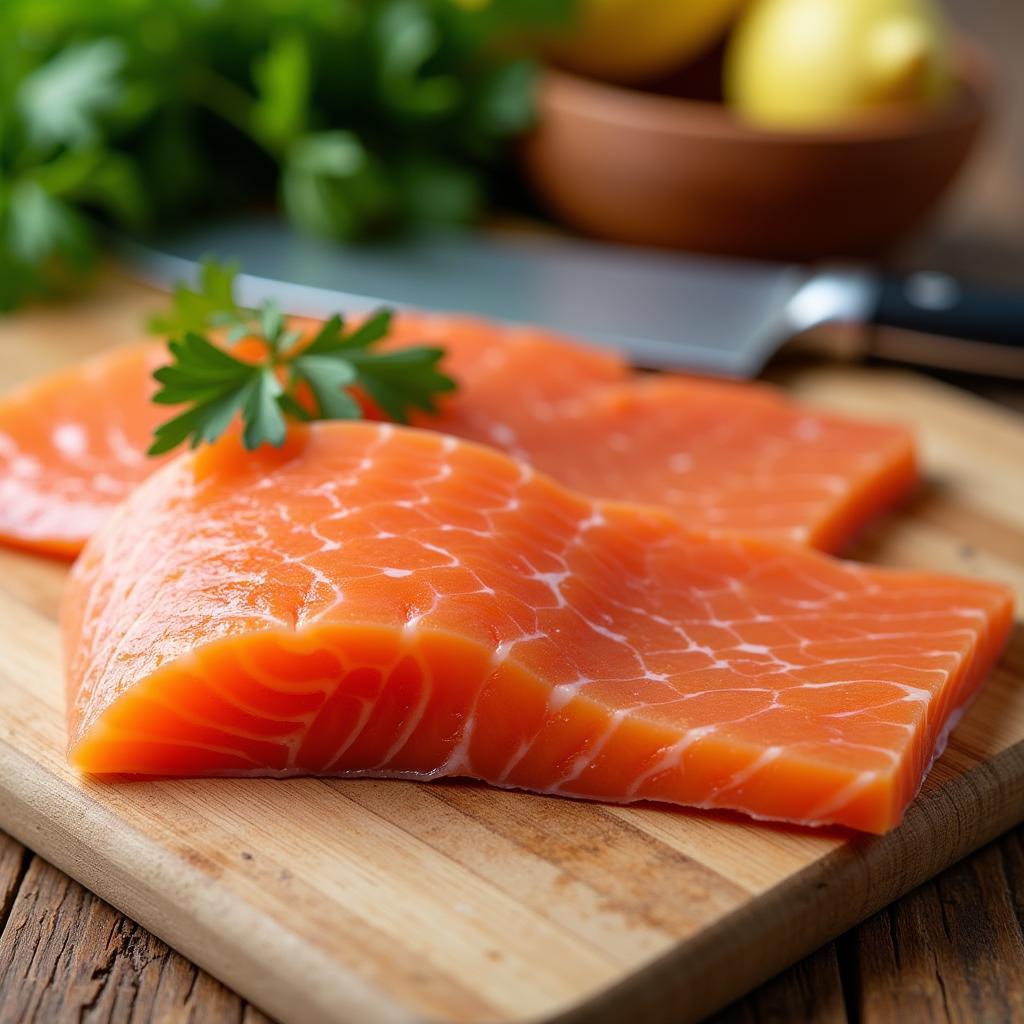Fresh dog food with salmon is growing in popularity among pet owners who want to give their furry friends the best possible nutrition. But is it worth the hype? In this article, we’ll explore the compelling reasons why you might want to consider incorporating fresh salmon into your dog’s diet.
Why Choose Fresh Salmon for Your Canine Companion?
 A Close-up of Fresh Salmon on a Cutting Board
A Close-up of Fresh Salmon on a Cutting Board
Unlike processed kibble that often relies on fillers and artificial ingredients, fresh salmon offers a wealth of natural goodness. Here are some key benefits that make fresh salmon a standout choice:
- High-Quality Protein: Salmon is packed with easily digestible protein, crucial for maintaining muscle mass, healthy growth, and providing your dog with sustained energy.
- Omega-3 Fatty Acids: These “good fats” are renowned for their anti-inflammatory properties, promoting healthy skin and coat, supporting joint health, and even boosting brain function.
- Vitamins and Minerals: Salmon is a natural source of essential vitamins and minerals like vitamin D, B vitamins, potassium, and selenium, all vital for your dog’s overall well-being.
For dog owners seeking a hypoallergenic option, a hypoallergenic dog food recipe often includes fish as a primary protein source due to its lower likelihood of triggering allergies compared to common allergens like chicken or beef.
Addressing Common Concerns About Fresh Dog Food Salmon
Some pet parents hesitate to switch to fresh dog food because of perceived difficulties or concerns. Let’s address some of these:
“Is Fresh Salmon Safe for Dogs?”
Absolutely, when prepared correctly. Always cook salmon thoroughly to eliminate potential parasites and bacteria. Avoid adding any seasonings, especially onions and garlic, which are toxic to dogs.
“What About Bones?”
While small, soft bones in cooked salmon can usually be consumed by dogs, it’s best to err on the side of caution and remove any large or cooked bones to prevent choking hazards.
Simple Ways to Include Fresh Salmon in Your Dog’s Diet
 Happy Dog Enjoying a Meal with Fresh Salmon
Happy Dog Enjoying a Meal with Fresh Salmon
- As a Meal Topper: Flake cooked salmon over your dog’s regular food to enhance flavor and add a nutritional boost.
- Mixed with Vegetables: Combine cooked salmon with steamed vegetables like carrots, green beans, or sweet potatoes for a complete and balanced meal.
- Frozen Treats: Puree cooked salmon with plain yogurt or water for refreshing frozen treats, especially enjoyable during warmer months.
Remember, transitioning to any new diet should be done gradually to avoid digestive upset. Always consult your veterinarian for personalized feeding guidelines based on your dog’s breed, age, activity level, and health condition.
If you’re considering a convenient and nutritionally complete option, explore a raw dog food subscription that includes fresh salmon as a key ingredient.
Choosing the Best Fresh Salmon for Your Dog
- Source: Opt for wild-caught salmon whenever possible, as it tends to be lower in contaminants and richer in omega-3 fatty acids compared to farmed salmon.
- Freshness: Choose salmon that looks vibrant with a fresh, ocean scent. Avoid fish that appears dull, slimy, or has a strong fishy odor.
The Verdict on Fresh Dog Food Salmon
Incorporating fresh salmon into your dog’s diet can offer numerous health advantages. From boosting skin and coat health to supporting joint function and enhancing overall well-being, the benefits of this nutrient-rich fish are undeniable. By making informed choices about sourcing and preparation, you can provide your canine companion with a tasty and healthy addition to their meals.
FAQs about Fresh Dog Food Salmon
Q: Can I feed my dog salmon every day?
A: While salmon is highly nutritious, it’s best to offer it in moderation as part of a balanced diet. Consult your veterinarian for personalized feeding recommendations.
Q: Is canned salmon okay for dogs?
A: Yes, canned salmon can be fed to dogs, but choose varieties packed in water without added salt or seasonings.
Q: What are the signs of salmon poisoning in dogs?
A: Salmon poisoning is a serious condition that can occur if a dog eats raw salmon infected with a specific parasite. Symptoms include vomiting, diarrhea, lethargy, loss of appetite, swollen lymph nodes, and fever. Seek immediate veterinary attention if you suspect your dog has consumed raw, contaminated salmon.
Q: Can puppies eat fresh salmon?
A: Yes, puppies can benefit from the nutrients in fresh salmon. However, start with small portions and monitor for any digestive issues.
Q: How do I store fresh salmon for my dog?
A: Keep fresh salmon refrigerated and use it within two days. You can also freeze it for longer storage.
For dog owners dealing with specific dietary needs, exploring options like fish food with high protein or researching a homemade dog food for itchy skin can provide valuable insights and solutions.
Want to test your knowledge about healthy dog food choices? Try our fun diet food crossword!
We encourage you to delve deeper into the world of canine nutrition. If you have more questions or need personalized advice, please don’t hesitate to contact us. You can reach our dedicated team at 02437655121 or minacones@gmail.com. Our office is located at 3PGH+8R9, ĐT70A, thôn Trung, Bắc Từ Liêm, Hà Nội, Việt Nam. We are here to assist you 24/7.